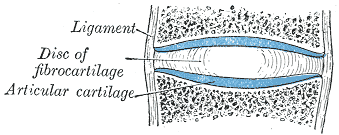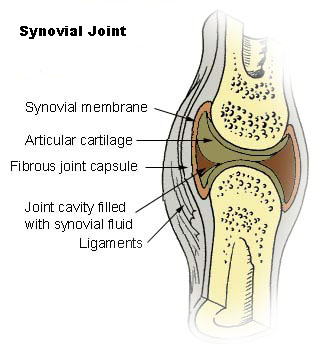Joint
 From Wikidoc - Reading time: 4 min
From Wikidoc - Reading time: 4 min
Editor-In-Chief: C. Michael Gibson, M.S., M.D. [1]
A joint is the location at which two or more bones make contact. They are constructed to allow movement and provide mechanical support, and are classified structurally and functionally.
Classification[edit | edit source]
Joints are mainly classified structurally and functionally. Structural classification is determined by how the bones connect to each other, while functional classification is determined by the degree of movement between the articulating bones. In practice, there is significant overlap between the two types of classifications. In example, the highly mobile diarthroses are universally synovial joints (and in practice the two terms are used interchangeably) though the first term refers to the functional classification and the second to the structural classification.
Terms ending in the suffix -sis are singlular and refer to just one joint, while -ses is the suffix for pluralization.
Structural classification[edit | edit source]

Structural classification names and divides joints according to how the bones are connected to each other. There are three structural classifications of joints:
Fibrous/Immovable - bones are connected by dense connective tissue, consisting mainly of collagen. The fibrous joints are further divided into three types:
- Sutures are found between bones of the skull. In fetal skulls the sutures are wide to allow slight movement during birth. They later become rigid (synarthrodial).
- Syndesmosis are found between long bones of the body, such as the radius and ulna in forearm and the fibula and tibia in leg. Unlike other fibrous joints, syndesmoses are moveable (amphiarthrodial), albeit not to such degree as synovial joints.
- Gomphosis is a joint between the root of a tooth and the sockets in the maxilla or mandible.
Cartilaginous - bones are connected entirely by cartilage. Cartilaginous joints allow more movement between bones than a fibrous joint but less than the highly mobile synovial joint. An example would be the joint between the manubrium and the sternum. Cartilaginous joints also forms the growth regions of immature long bones and the intervertebral discs of the spinal column.
- Primary cartilaginous joints - Known as "synchondroses". Bones are connected by hyaline cartilage or fibrocartilage, sometimes occurring between ossification centers. This cartilage may ossify with age. Examples in humans are the joint between the first rib and the manubrium of the sternum, and the "growth plates" between ossification centers in long bones. These joints usually allow no movement, or minimal movement in the case of the manubriosternal and first manubriocostal joints.
- Secondary cartilaginous joints - Known as "symphyses". Fibrocartilaginous joints, usually occurring in the midline. Examples in human anatomy would be the intervertebral discs, and the pubic symphysis. These joints allow a little movement.
Synovial - synovial joints have a space between the articulating bones for synovial fluid. This classification contains joints that are the most mobile of the three, and includes the knee and shoulder. These are further classified into ball and socket joints, condyloid joints, saddle joints, hinge joints, pivot joints, and gliding joints.
Functional classification[edit | edit source]

Joints can also be classified functionally, by the degree of mobility they allow.
Synarthrosis - permit little or no mobility. Most synarthrosis joints are fibrous. They can be categorised by how the two bones are joined together:
- Synchondroses are joints where the two bones are connected by a piece of cartilage.
- Synostoses are where two bones that are initially separted eventually fuse together, essentially becoming one bone. In humans the plates of the cranium fuse together as a child approaches adulthood. Children whose craniums fuse too early may suffer deformities and brain damage as the skull does not expand properly to accommodate the growing brain, a condition known as craniostenosis.
Amphiarthrosis - permit slight mobility. The two bone surfaces at the joint are both covered in hyaline cartilage and joined by strands of fibrocartilage. Most amphiarthrosis joints are cartilaginous.
Diarthrosis - permit a variety of movements (e.g. flexion, adduction, pronation). Only synovial joints are diarthrodial. They can be divided into six classes:
- 1. Ball and Socket - such as the shoulder or the hip and femur.
- 2. Hinge - such as the elbow.
- 3. Pivot - such as the radius and ulna.
- 4. Condyloid (or ellipsoidal) - such as the wrist between radius and carpals, or knee
- 5. Saddle - such as the joint between carpal thumbs and metacarpals.
- 6. Gliding - such as between the carpals.
Biomechanical classification[edit | edit source]
Joints can also be classified based on their anatomy or on their biomechanic properties. According to the anatomic classification, joints are subdivided into simple and compound, depending on the number of bones involved, and into complex and combination joints.
- Simple Joint: 2 articulation surfaces (eg. shoulder joint, hip joint)
- Compound Joint: 3 or more articulation surfaces (eg. radiocarpal joint)
- Complex Joint: 3 or more articulation surfaces AND an articular disc
See also[edit | edit source]
| Wikimedia Commons has media related to joints. |
- Arthritis
- Arthrology, the science concerned with the anatomy, function, dysfunction and treatment of joints.
- Kinesiology, the study of musculoskeletal movements.
- Replacement joint
External links[edit | edit source]
Template:Joints Template:Joints of head and neck Template:Joints of upper limbs Template:Joints of torso Template:Joints of lower limbs
br:Mell ca:Articulació (anatomia) cs:Kloub da:Led (anatomi) de:Gelenk eo:Artiko ga:Alt (anatamaíocht) gd:Alt (corp) hr:Zglob id:Sendi it:Articolazione he:מפרק lt:Sąnarys nl:Gewricht simple:Joint sk:Kĺb (anatómia) fi:Nivel sv:Led uk:Суглоб
 KSF
KSF